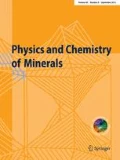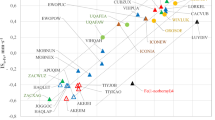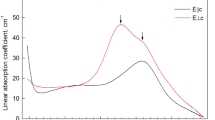Abstract
A molecular orbital description, based on Xα-Scattered wave calculations on a (FeTiO10)14− cluster, is given for Fe2+ → Ti4+ charge transfer transitions in minerals. The calculated energy for the lowest Fe2+ → Ti4+ metal-metal charge transfer transition is 18040 cm−1 in reasonable agreement with energies observed in the optical spectra of Fe-Ti oxides and silicates. As in the case of Fe2+ → Fe3+ charge transfer in mixed-valence iron oxides and silicates, Fe2+ → Ti4+ charge transfer is associated with Fe-Ti bonding across shared polyhedral edges. Such bonding results from the overlap of the Fe(t 2g ) and Ti(t 2g ) 3d orbitals.
Similar content being viewed by others
References
Burns RG, Parkin KM, Loeffler BM, Leung IS, Abu-Eid RM (1976) Further characterization of spectral features attributable to titanium on the moon. Proc Lunar Sci Conf 7th:2561–2578
Faye GH, Harris DC (1969) On the origin of color and pleochroism in andalusite from Brazil. Can Mineral 10:47–56
Johnson KH (1973) Scattered wave theory of the chemical bond. Adv Quantum Chem 7:143–185
Manning PG (1977) Charge transfer interactions and the origin of color in brown vesuvianite. Can Mineral 15:508–511
Mao KH, Bell PM, Virgo D (1977) Crystal field spectra of fassite from the Angra do Reis meteorite. Earth Planet Sci Lett 35:352–356
Norman JG (1976) Non-empirical versus empirical choices of over-lapping sphere radii ratios in SCF-Xα-SW calculations on ClO −4 and SO2. Mol Phys 31:1191–1198
Reynolds ML (1965) Charge transfer from inorganic ions to titanium (IV). J Chem Soc 2991–2993
Robin MB, Day P (1967) Mixed valence chemistry — a survey and classification. Adv Inorg Chem Radiochem 10:247–422
Schwarz K (1972) Optimization of the statistical exchange parameter α for the free atoms H through Nb. Phys Rev B5:2466–2468
Sherman DM (1987) Molecular orbital (SCF-Xα-SW) theory of metal-metal charge transfer processes in minerals. I. Application to Fe2+ → Fe3+ charge transfer and “electron delocalization” in mixed valence iron oxides and silicates. Phys Chem Minerals 14:355–363
Slater JC (1974) The self-consistent field method for atoms, molecules and solids. McGraw Hill, New York
Smith G (1977) Low temperature optical studies of metal-metal charge transfer transitions in various minerals. Can Mineral 15:500–507
Strens RGJ, Wood BJ (1979) Diffuse reflectance spectra and optical properties of some iron and titanium oxides and oxyhydroxides. Mineral Mag 43:347–354
Author information
Authors and Affiliations
Rights and permissions
About this article
Cite this article
Sherman, D.M. Molecular orbital (SCF-Xα-SW) theory of metal-metal charge transfer processes in minerals. Phys Chem Minerals 14, 364–367 (1987). https://doi.org/10.1007/BF00309811
Received:
Issue Date:
DOI: https://doi.org/10.1007/BF00309811




